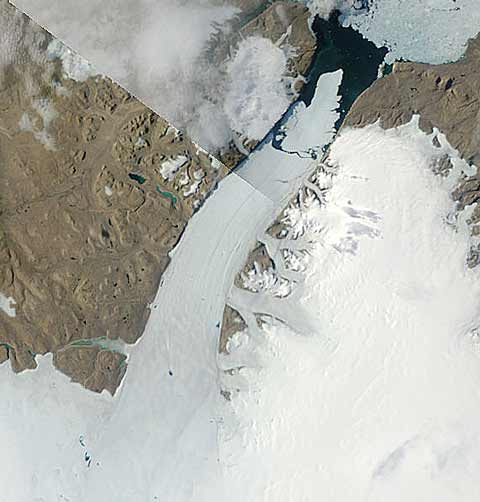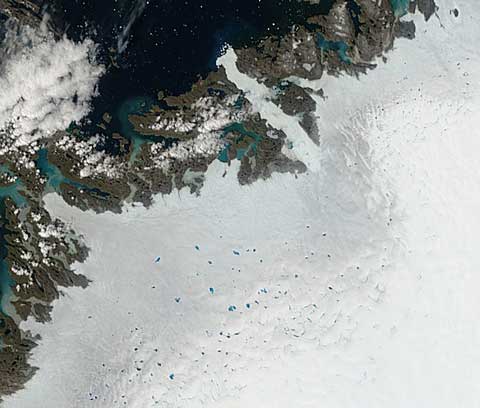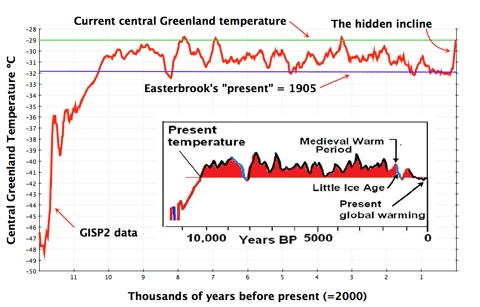The Petermann Glacier in northwest Greenland has calved a massive “ice island” from its floating tongue (the largest in northern hemisphere), as the MODIS image above demonstrates. The island is approximately 260 square kilometers in area, making it equivalent to (arbitrary choice of geographical comparison appropriate to blog) eleven Rangitoto Islands (or four Manhattans, or about one eightieth of the area of Wales), and broke off at the end of last week. It contains enough fresh water (being nearly 200m thick) to keep the USA supplied with tap water for 120 days. NOAA’s National Ice Centre provides another view, with the ice island outlined in red:
Tag: Greenland
It’s grim up North #2
From NASA’s eyes in the sky, this is a view of the west coast of Greenland downloaded earlier today, looking down on the Ilulissat Icefjord — the outlet for the Jakobshavn Isbrae, the biggest outlet glacier in Greenland and the largest in the northern hemisphere. It’s the long tongue of white reaching up from right of centre to the top of the frame, where you can see the white dots of newly calved icebergs drifting out into Disko Bay (click on the picture to see the 250m/pixel original image at the MODIS site). All very interesting, of course, but I’m posting it to show the numerous large lakes of glacial meltwater that have appeared on top of the ice sheet over recent weeks. At the edge of the ice sheet, the winter snow has melted revealing the greyer ice underneath, but as you climb up the ice away from the coast you get back up into unmelted snow (bottom right). And there are lakes like this a very long way up the west coast, all primed to deliver their water down through moulins to the base of the sheet and thence out to sea, or over the surface in glacial rivers.
I hope this illustrates that there’s more to a melting Arctic than the sea ice — the rest of this post is catching up with sea ice news…
Cooling-gate: the 100 years of warming Easterbrook wants you to ignore
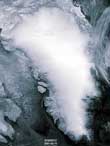 Evidence that Don Easterbrook did more than misrepresent and alter a graph in order to remove evidence of recent warming in his presentation to the recent Heartland “climate conference” is beginning to emerge. It now appears that he has been misusing one of the most important paleoclimate temperature data series, compiled from the GISP2 Greenland ice core, effectively hiding a full 100 years of recent warming. His “rebuttal” of my revelations that he had misused a graph from Global Warming Art includes this assertion:
Evidence that Don Easterbrook did more than misrepresent and alter a graph in order to remove evidence of recent warming in his presentation to the recent Heartland “climate conference” is beginning to emerge. It now appears that he has been misusing one of the most important paleoclimate temperature data series, compiled from the GISP2 Greenland ice core, effectively hiding a full 100 years of recent warming. His “rebuttal” of my revelations that he had misused a graph from Global Warming Art includes this assertion:
…below is the Greenland data for the past 10,000 years (Holocene) from the published paper by Cuffy and Clow (1997), two distinguished US scientists. Note that temperatures for almost all of the past 10,000 years have been warmer than present.
In my post yesterday, I suggested (on the basis of the notes accompanying the raw δ18O data), that the “present” Easterbrook was referring to was 1950. It now appears I was being far too generous. Thanks to a bit of detective work by MartinM in the comments to that post, the data set used by Easterbrook to draw his version of a Holocene temperature graph turns out to be the temperature series derived from the δ18O data by Richard Alley: Alley, R.B. 2004. GISP2 Ice Core Temperature and Accumulation Data. IGBP PAGES/World Data Center for Paleoclimatology
Data Contribution Series #2004-013. NOAA/NGDC Paleoclimatology Program, Boulder CO, USA (ftp download here). The most recent temperature data point in that series is 1905, and that’s the point Easterbrook labels as the present. To make his case he has to make a full century’s worth of warming disappear.
I downloaded Alley’s data and plotted it with my new favourite graphing tool. This is what it looks like:
I’ve inset the graph from Easterbrook’s “rebuttal”, and added a couple of helpful lines (click for a bigger version). I think it’s pretty clear that the data behind both graphs is the same. There’s more detail in my plot, but the key features are all in the right places. I’ve added a blue line to represent Easterbrook’s “present temperature”. The green line represents an estimate of current temperatures in central Greenland. I looked at the nearest station with a 100+ year record in the GISS database (Angmagssalik), and used a Mk 1 eyeball to estimate a 2.5ºC increase over the century (I’d welcome a more accurate estimate, if anyone’s prepared to dig one up). The difference between the green and blue lines is the warming that Easterbrook wants to ignore. His statement that temperatures for almost all of the past 10,000 years have been warmer than present is shown to be complete nonsense. There are three points in the last 10,000 years when temperatures high up on the Greenland ice sheet were similar to today, but by no stretch of anyone’s imagination can it be said to have been warmer for most of the time. The incline he’s trying to hide is one of the largest and steepest in the last ten millenia…
The same temperature series also appears to form the basis for Monckton’s famous “Curry & Clow” slide from early 2009:
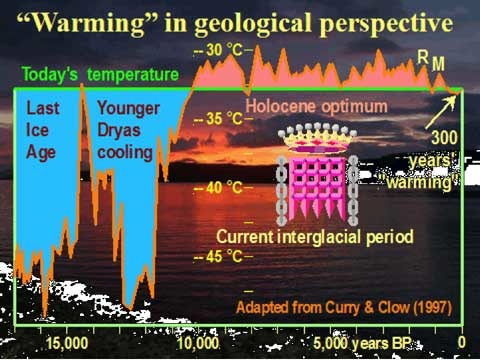
Monckton credits the wrong people, of course, but adds a helpful “300 years of warming” arrow. Like Easterbrook, he omits the last 100 years of warming. This is what he said at the time:
Seen in the geological perspective of the last 17,000 years, the 300 years of recent warming, nearly all of which must have been natural, for we could not have had any significant influence except in the past 25 years, are manifestly insignificant.
The 300 years of recent warming are of course the 300 years up to 1905. What has happened since then is manifestly significant. This sort of misdirection is par for the course for Monckton, but what about Easterbrook?
If he knowingly misrepresented 1905 as the “present” (and given that he claims to have “the entire Greenland oxygen isotope data in my computer and use it extensively to plot data” that has to be a real possibility), then he is clearly misusing the data and misleading his audience. The intellectual dishonesty involved is breathtaking. His audience may want to be mislead, but that is irrelevant. On the other hand if, as a distinguished academic with a long career studying (amongst other things) glaciers and climate change, he really doesn’t know that the data series stops in 1905, then he is demonstrating ignorance of a sort that would embarrass any student.
So where’s the investigation of this academic fraud? Where are the hordes of bloggers and journalists screaming blue murder about the manipulation of data to tell a convenient story? Here’s Joseph Bast, president of the Heartland Institute, writing about the so-called “climategate” affair last November:
Looking at how past disclosures of fraud in the global warming debate have been dismissed or ignored by the mainstream media leads me to suspect they will try to sweep this, too, under the rug. But thanks to the Internet, millions of people will be able to read the emails themselves and make up their own minds. This incident, then, will not be forgotten. The journalists who attempt to spin it away and the politicians who try to ignore it will further damage their own credibility, and perhaps see their careers shortened as a consequence.
How very true. I look forward to Bast issuing a statement apologising for being a party to Easterbrook’s fraud, for providing him with a platform to mislead and misinform, and instituting an in-depth investigation into the background of Cooling-gate. But I suspect he will be doing his best to ignore the whole affair. I leave it to the reader to decide what that does for the credibility of Bast, Heartland, and the scientists who shared a stage with Easterbrook at Heartland’s Chicago conference.
[Update 29/5: My graph revised and improved, see comment below]
Winter 2010: cold in places, exceptionally hot in others
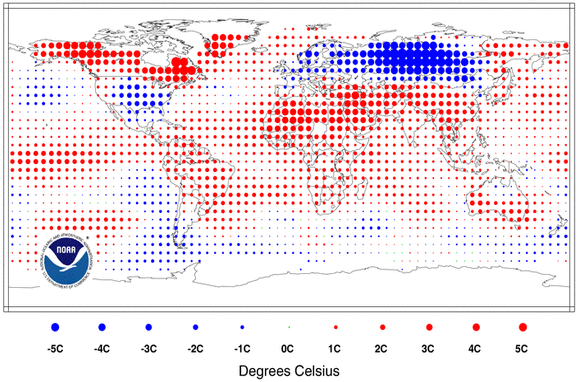 Northern hemisphere winter, that is — we’re still in a nice warm autumn down here. Before I disappear for a couple of days of hectic activity (vintage 2010 tomorrow, bottling the ‘09 on Monday), I just wanted to draw attention to a couple of articles I read over my Saturday morning toast (fine bread from the farmer’s market). The first is the review of the northern hemisphere winter by Bob Henson at UCAR: an interesting overview of how El Niño and the Arctic Oscillation combined to bring cold and snow to the US and Europe, but record breaking warmth to Canada, Greenland, North Africa and the Middle East. Henson draws on a fascinating statistical analysis of the winter by Geert Jan van Oldenborgh of the Netherlands Meteorological Institute(KNMI), putting the combination of cold, snow and warmth into the context of a changing climate.
Northern hemisphere winter, that is — we’re still in a nice warm autumn down here. Before I disappear for a couple of days of hectic activity (vintage 2010 tomorrow, bottling the ‘09 on Monday), I just wanted to draw attention to a couple of articles I read over my Saturday morning toast (fine bread from the farmer’s market). The first is the review of the northern hemisphere winter by Bob Henson at UCAR: an interesting overview of how El Niño and the Arctic Oscillation combined to bring cold and snow to the US and Europe, but record breaking warmth to Canada, Greenland, North Africa and the Middle East. Henson draws on a fascinating statistical analysis of the winter by Geert Jan van Oldenborgh of the Netherlands Meteorological Institute(KNMI), putting the combination of cold, snow and warmth into the context of a changing climate.
Van Oldenborgh assesses the the likelihood of the various temperature and snowfall anomalies in the context of an unchanging climate, and on the change that current trends indicate has already occurred. The map above left (click to see the original via KNMI) shows how often winters as cold as 2010 would be expected in the current (changing) climate: 10-50 year return periods are common, stretching out to 100-500 years in parts of Siberia. The map at right shows the warm extremes. Even in a warming climate, winter 2010 was a 10,000 year event — extremely unusual — in parts of the Middle East. Egypt’s winter, for instance, was a full 1ºC above the previous record, and 3ºC above the mean. Southern Greenland was also exceptionally warm. Compared with an unchanging climate (assuming that the probabilities for 1971-2000 still apply), the cold anomalies are less extreme because cold events were more common in the past, and the heat extremes were greater. But however you analyse the situation, the warmth experienced in Canada and the Middle East was more unusual than the US and European cold spells. It’s well worth reading van Oldenborgh’s article, even if you’d rather be eating chocolate eggs.
PS: Also noteworthy: David Appell takes a look at why current sea ice extent/areas don’t tell us the ice is “back to normal”, as some would have us believe. In the words of the old joke, sceptics are asserting “never mind the quality, feel the width.”
May all your buns be cross, and hot. Happy Easter.
It’s grim up North (but beautiful too)
 Blogs, or to spell out the contraction, web logs, were originally just that: a log of interesting things found on the internet. Yesterday was a day when I rediscovered that tradition. Prompted by a comment from glaciologist Mauri Pelto on my recent Greenland post, I started off by making a visit to NASA’s MODIS Rapid Response System image site, which provides access to near real-time imagery from the Aqua and Terra satellites (click on Near-real-time production under “quick links” to be taken to the most recent images). The images aren’t fully processed (you can see “stripes” and slight distortions), but they give you a good look at what’s going on. I first went and had a look at what spring on the Petermann glacier in NW Greenland looked like:
Blogs, or to spell out the contraction, web logs, were originally just that: a log of interesting things found on the internet. Yesterday was a day when I rediscovered that tradition. Prompted by a comment from glaciologist Mauri Pelto on my recent Greenland post, I started off by making a visit to NASA’s MODIS Rapid Response System image site, which provides access to near real-time imagery from the Aqua and Terra satellites (click on Near-real-time production under “quick links” to be taken to the most recent images). The images aren’t fully processed (you can see “stripes” and slight distortions), but they give you a good look at what’s going on. I first went and had a look at what spring on the Petermann glacier in NW Greenland looked like:

